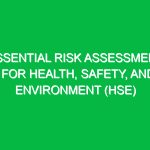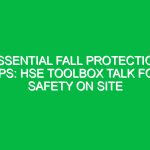Understanding Work-at-Height in the HSE Context
Work-at-height refers to any task performed above ground level where a person could fall and injure themselves or others. This includes activities conducted on ladders, scaffolds, rooftops, or any elevated work platform. In the Health, Safety, and Environment (HSE) domain, ensuring safety when working at height is crucial. Falls from height are among the leading causes of workplace injuries and fatalities, making it a top priority for employers and safety professionals alike.
The relevance of work-at-height safety transcends industries, affecting construction, maintenance, warehousing, and even office environments. The importance of robust safety measures cannot be overstated; a fall at height can lead to serious injuries, significant financial costs, and even legal repercussions. This article will explore essential safety tips, best practices, and regulations surrounding work-at-height, aiming to foster a safer work environment.
Key Aspects of Work-at-Height Safety
Understanding the Risks
Before delving into safety tips, it is vital to understand the risks involved in work-at-height. According to HSE statistics, falls account for a considerable percentage of workplace fatalities. The risks associated with work-at-height can include:
- Unstable surfaces: Working on ladders or scaffolding can pose stability issues, particularly if the ground is uneven.
- Equipment failure: Poorly maintained or inappropriate equipment can lead to accidents.
- Weather conditions: Wind, rain, and other adverse weather can significantly increase the risk of falling.
- Inadequate training: Workers who are not trained properly may not understand how to use equipment safely or recognize potential hazards.
Recognizing these risks is the first step to creating a safer workplace.
Best Practices for Work-at-Height Safety
Implementing best practices is essential for mitigating risks associated with work-at-height. Here are several key practices to consider:
1. Conduct a Risk Assessment
Before any work begins, conduct a thorough risk assessment. This should include identifying potential hazards, evaluating the level of risk, and implementing control measures to mitigate those risks. Regularly review and update the assessment, especially when conditions change or new tasks are introduced.
2. Use the Right Equipment
Choosing the right equipment is vital for safety. This involves selecting appropriate ladders, scaffolding, or elevated work platforms. Ensure that all equipment meets safety standards and is regularly inspected for wear and tear. For instance, always opt for a scaffold that is designed for the specific task at hand, rather than making do with what is available.
3. Provide Training and Supervision
Training is a cornerstone of work-at-height safety. Ensure that all employees receive comprehensive training that covers the safe use of equipment, hazard recognition, and emergency procedures. Additionally, provide supervision when workers are operating at height, especially for less experienced individuals.
4. Implement Fall Protection Systems
Fall protection systems are crucial when working at height. This can include guardrails, safety nets, and personal fall arrest systems. For example, when working on a roof, using guardrails can prevent falls, while personal fall arrest systems can arrest a fall if it occurs, reducing the risk of injury.
5. Develop an Emergency Response Plan
In the unfortunate event of an accident, having a well-structured emergency response plan is essential. This should include procedures for rescue, first aid, and communication with emergency services. Regular drills can help ensure that employees know what to do in case of an emergency.
Potential Hazards and Safety Considerations
Identifying potential hazards is not just about recognizing risks; it also involves understanding how to mitigate them effectively. Below are common hazards associated with work-at-height:
1. Overreaching
Workers often overreach while on ladders or scaffolds, leading to loss of balance and falls. Implementing a strict guideline that discourages overreaching can significantly reduce this risk.
2. Improper Use of Equipment
Whether it’s using a ladder incorrectly or failing to secure scaffolding, improper equipment use is a common hazard. Ensure that all employees are trained in the proper use of equipment and conduct regular inspections to ensure compliance.
3. Lack of Communication
Effective communication among team members is vital when working at height. Establish clear communication protocols to ensure that everyone is aware of where others are working and what tasks they are performing.
Regulations and Standards Governing Work-at-Height
Understanding the legal framework surrounding work-at-height is crucial for compliance and safety. Various regulations govern this area, and organizations must adhere to them to ensure a safe working environment.
1. The Work at Height Regulations 2005 (UK)
In the UK, the Work at Height Regulations 2005 outlines the duties of employers to ensure the safety of employees working at height. Key aspects of this regulation include:
- Planning and organizing work to minimize the risk of falls.
- Using appropriate work equipment that is safe for the task.
- Providing training and information to employees.
Failure to comply with these regulations can result in hefty fines and legal consequences.
2. OSHA Regulations (USA)
In the United States, the Occupational Safety and Health Administration (OSHA) sets forth regulations that govern work-at-height activities. These include requirements for fall protection, training, and equipment safety. Employers must ensure that they are familiar with these regulations to avoid penalties and ensure worker safety.
Real-Life Examples and Insights
Real-life scenarios often illustrate the importance of adhering to work-at-height safety guidelines. Consider the case of a construction worker who fell from a rooftop due to a lack of guardrails and inadequate training. This incident not only resulted in severe injury but also led to legal action against the employer for failing to provide a safe working environment. This example highlights the critical need for thorough training and compliance with safety regulations.
On the other hand, a manufacturing facility implemented a comprehensive work-at-height safety program that included training sessions, regular equipment checks, and ongoing risk assessments. As a result, they reported a significant decrease in incidents related to falls from height, demonstrating that proactive measures can lead to safer workplaces.
Conclusion
Ensuring safety when working at height is a vital aspect of maintaining a secure workplace. By understanding the risks, implementing best practices, and adhering to relevant regulations, organizations can significantly reduce the likelihood of accidents. The importance of training, proper equipment, and effective communication cannot be understated.
As we navigate the complexities of the workplace, it is crucial to prioritize health, safety, and environmental sustainability. By fostering a culture of safety and compliance, we not only protect our employees but also contribute to a safer community and environment. As we reflect on work-at-height safety, let us commit to continuous improvement and vigilance in our practices.


